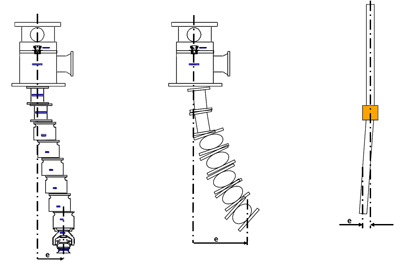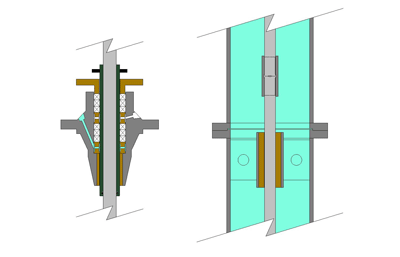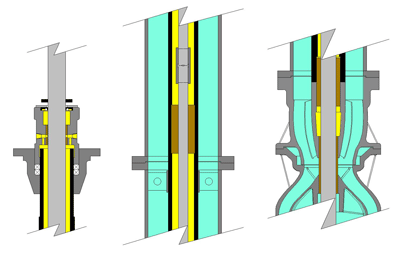Pumps & Systems
April, 2010
Typical vertical pump types include turbine, mixed and axial flow. The Hydraulic Institute classifies these pumps as type VS (Vertically Suspended). Unlike horizontal pumps, these pumps typically have the pumping element (impeller, diffuser, column pipe and pump shaft) submerged in the pumpage. Therefore, the metallurgy of all pump components must be compatible with the pumpage to achieve adequate life (MTBF).
The vertical pump is versatile, both in construction styles and hydraulic capabilities from 1,500 through 10,000 specific speed. It is used effectively in many industries such as nuclear power, fossil power, oil and gas, mining, municipal, general industrial and agricultural markets.
To properly consider repair upgrades, one should be familiar with the operational service of the pump in its specific application. Some vertical pump sensitivities include:
- High Speed-Stator and rotor alignment, cavitation, rotor balance
- High Specific Speed-Intake design, cavitation
- Corrosive Service-Materials compatibility, protective coatings
- Well Pumps-Lineshaft lubrication, start-up and shut-down coordination with valving, variable frequency drive operation, installation
It may be possible to more than double a standard manufactured vertical pump’s life by upgrading the pump repair to a “precision remanufacture.” The pump vibration will be reduced and can be verified upon start-up as proof of the upgrade. The repair and upgrade cost is usually a small item in the pump’s life cycle cost.

Figure 1. (l.) The resultant eccentricity between rotor and stator caused by loose fits between the bowls and columns. (center) The resultant eccentricity caused by a lack of parallelism between the mating faces. (r.) The resultant rotor eccentricities caused by loose fit by threaded couplings.
Vertical Pump Repair Concepts
The overriding repair concept for vertical pumps is two-fold: establish true centerline compatibility between the rotor and stator at the motor-to-discharge head flange location and ensure that the maximum relative radial displacement of the stator to the rotor-at any point for the pump’s entire length of the pump-does not exceed the minimum clearance of the closest running fit.
The goal is to insert the rotating assembly into the stationary components with uniform radial clearance maintained through the pump from the lower bearing to the head stuffing box. This can only be achieved through the application of tight tolerancing standards.
Important Considerations When Making Upgrades
Bearing Spacing
If the spacing of the bearings is too far apart, a natural frequency on the shaft can develop and cause unwanted vibration problems. If the pump service provider has an in-house engineering staff, then this factor is usually not an issue when upgrades are proposed in the repair plan.

Figure 2. Open lineshaft, product-lubricated
Lineshaft Lubrication Methods and Bearing Lubrication for Long Pumps and Below-Base Discharge
The two types of lubrication systems are open lineshaft, which is product-lubricated, and enclosed lineshaft, which is fresh water flush, oil-lubricated (gravity feed or pressurized) and grease-packed. There are many valid reasons to change from one method of bearing lubrication to another, and if doing so, all given considerations should be discussed.
Bearing Materials
Bearing materials vary due to product temperature, abrasiveness, lubricity, corrosiveness or any combination of these. Availability and/or reliability of a good lubricant may also be an issue.
Shaft Coupling Design
The shaft coupling design can be threaded, keyed (various types) or neither. Larger shafts typically use the keyed shaft coupling design; the threaded design depends on the type of material used, reverse-rotation issues, etc. Couplings may not be needed at all for short pumps depending on the application and shaft size.

Figure 3. Enclosed lineshaft, water flush

Figure 4. Enclosed lineshaft, oil lube
Leakage
Determining how to handle leakage depends on the product pumped. If the pumpage is flammable, a mechanical seal may be required instead of a packing box to avoid any leakage. If pumping water, a packing box may be more effective than a mechanical seal since decreases in temperature could cause the water to freeze and damage the mechanical seal. If pumping a corrosive material, a packing box that drips would require consistent cleanup. Other leak-free and maintenance-free designs exist that can be considered.
Pump Stiffness and Weight
It is important to evaluate the pump in its whole environment when determining the effectiveness of upgrades. Details to consider include the dimensions of the entire pump, data on the baseplate and mounting. This is crucial when trying to avoid natural frequency and vibration problems. A qualified pump service provider considers this information when determining the root cause analysis of pump failure and factors it into the pump repair plan.
Pull-Out Designs
Most repairs of this type do not require pulling out the whole pump, and upgrades that are made must ensure the proper tolerances of the outer column/drop pipe assembly are addressed. Do not ignore what cannot be seen.
Upgrade Options for Bearing and Sleeve Materials
Enclosed lineshaft pumps in non-corrosive service are typically constructed with bronze bearings and stainless steel shafts. Bearing upgrades are typically performed on open lineshaft, product-lubricated vertical pumps.
For open lineshaft vertical pumps:
- Sleeves, shaft bearing journal and bearing ID can be hard-coated
- Sleeves and shaft bearing journal can be bare metal, uncoated
- Sleeves and shaft bearing journal can be hardened metal
- Sleeves and shaft bearing journal can be surface coated or fuse-coated
- Bearings can be
- Metallic (bronze, cast iron or Nitronic stainless steel)
- Carbon (with various fills)
- Rubber (pop-in or Cutlass/Marine)
- Other materials, such as glass-filled epoxy, PTFE (polytetrafluoroethylene) or composites/plastics

Figure 5. Enclosed lineshaft, grease lube
Key Points for Vertical Pump Installation
Proper In-Transit Supports
Pumps are often transported to the jobsite on flatbed trailers with heavy chains, which can bend and negatively affect the newly rebuilt pump. Proper supports are mandatory when delivering a rebuilt pump back into service; straps and/or chains should only be used in the locations where blocking is used.
Installation Rigging
How is the repaired pump lifted off the truck? If only using a center lift, the center will have too much stress and can bend. Two-point rigging is recommended to lift the vertical pump from the top and bottom. Using special slide pulleys, the rebuilt pump can be moved from the horizontal position off the truck to the vertical position for installation.
Precision Alignment of Vertical Driver Register, Base, Shaft and Coupling
The driver is usually repaired separately from the vertical pump, and the end user is responsible for installing all components. It is critical that these components are precision-aligned at time of installation or the upgrades and stringent repair practices have no effect. For this reason, it is imperative to have a highly skilled field service team to oversee and assist with vertical pump installation.
Conclusion
There are benefits to be gained from implementing upgrades during the repair process, but it all begins with a qualified service provider and thorough inspection as the basis for appropriate recommendations. Improving fits and tolerances as well as implementing upgrades can reduce vibration, increase bearing life, reduce power consumption and extend a pump’s mean time between repairs. Take advantage of the new technologies that can help vertical pumps run better and make sure to use an experienced service provider.
http://www.pump-zone.com/pumps/vertical-turbine-pumps/vertical-pump-repair-and-u…
